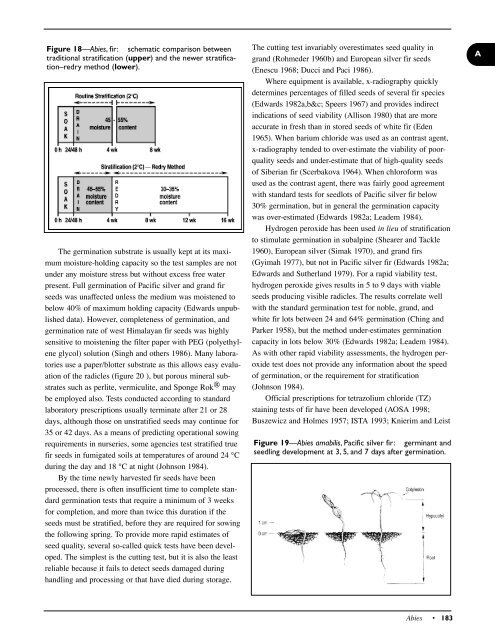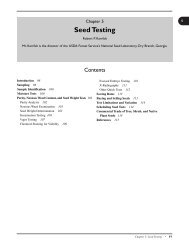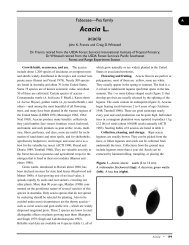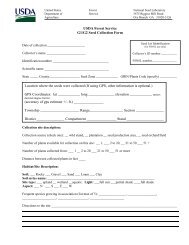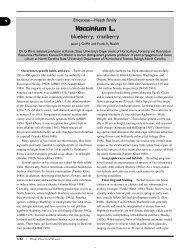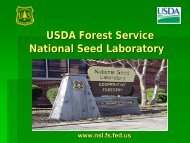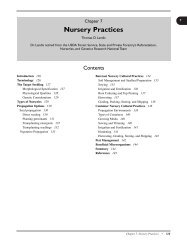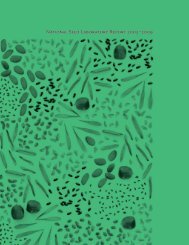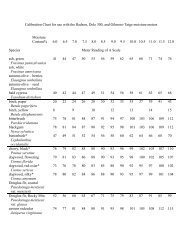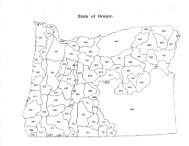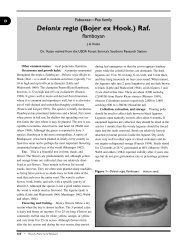Figure 18—<strong>Abies</strong>, fir: schematic comparison betweentraditional stratification (upper) and the newer stratification–redrymethod (lower).The germination substrate is usually kept at its maximummoisture-holding capacity so the test samples are notunder any moisture stress but without excess free waterpresent. Full germination of Pacific silver and grand firseeds was unaffected unless the medium was moistened tobelow 40% of maximum holding capacity (Edwards unpublisheddata). However, completeness of germination, andgermination rate of west Himalayan fir seeds was highlysensitive to moistening the filter paper with PEG (polyethyleneglycol) solution (Singh and others 1986). Many laboratoriesuse a paper/blotter substrate as this allows easy evaluationof the radicles (figure 20 ), but porous mineral substratessuch as perlite, vermiculite, and Sponge Rok ® maybe employed also. Tests conducted according to standardlaboratory prescriptions usually terminate after 21 or 28days, although those on unstratified seeds may continue for35 or 42 days. As a means of predicting operational sowingrequirements in nurseries, some agencies test stratified truefir seeds in fumigated soils at temperatures of around 24 °Cduring the day and 18 °C at night (Johnson 1984).By the time newly harvested fir seeds have beenprocessed, there is often insufficient time to complete standardgermination tests that require a minimum of 3 weeksfor completion, and more than twice this duration if theseeds must be stratified, before they are required for sowingthe following spring. To provide more rapid estimates ofseed quality, several so-called quick tests have been developed.The simplest is the cutting test, but it is also the leastreliable because it fails to detect seeds damaged duringhandling and processing or that have died during storage.The cutting test invariably overestimates seed quality ingrand (Rohmeder 1960b) and European silver fir seeds(Enescu 1968; Ducci and Paci 1986).Where equipment is available, x-radiography quicklydetermines percentages of filled seeds of several fir species(Edwards 1982a,b&c; Speers 1967) and provides indirectindications of seed viability (Allison 1980) that are moreaccurate in fresh than in stored seeds of white fir (Eden1965). When barium chloride was used as an contrast agent,x-radiography tended to over-estimate the viability of poorqualityseeds and under-estimate that of high-quality seedsof Siberian fir (Scerbakova 1964). When chloroform wasused as the contrast agent, there was fairly good agreementwith standard tests for seedlots of Pacific silver fir below30% germination, but in general the germination capacitywas over-estimated (Edwards 1982a; Leadem 1984).Hydrogen peroxide has been used in lieu of stratificationto stimulate germination in subalpine (Shearer and Tackle1960), European silver (Simak 1970), and grand firs(Gyimah 1977), but not in Pacific silver fir (Edwards 1982a;Edwards and Sutherland 1979). For a rapid viability test,hydrogen peroxide gives results in 5 to 9 days with viableseeds producing visible radicles. The results correlate wellwith the standard germination test for noble, grand, andwhite fir lots between 24 and 64% germination (Ching andParker 1958), but the method under-estimates germinationcapacity in lots below 30% (Edwards 1982a; Leadem 1984).As with other rapid viability assessments, the hydrogen peroxidetest does not provide any information about the speedof germination, or the requirement for stratification(Johnson 1984).Official prescriptions for tetrazolium chloride (TZ)staining tests of fir have been developed (AOSA 1998;Buszewicz and Holmes 1957; ISTA 1993; Knierim and LeistFigure 19—<strong>Abies</strong> amabilis, Pacific silver fir: germinant andseedling development at 3, 5, and 7 days after germination.A<strong>Abies</strong> • 183
A1988). Tetrazolium test results often correlate with seedlingemergence experienced in nursery sowings (Franklin1974b). Tetrazolium agreement with standard germinationtests can vary among lots of many species (Ducci and Paci1986; Flemion and Poole 1948; Leadem 1984; Rohmeder1960b), and a “best estimate” of 2 methods (for example,hydrogen peroxide and TZ) has been proposed for rapidtests (Edwards 1982a). An excised embryo method thatrequires about 1 week for assessment of European silver firhas been described (Nyholm 1956), but no official prescriptionsfor fir have been developed. Although “quick tests”may be completed in a matter of hours, or days, comparedto weeks required for standard germination tests, not only dothey over-estimate (Franklin 1974b; Rohmeder 1960b; Stein1967) or underestimate (Edwards 1982a; Leadem 1984) viabilityof fir seeds, they are more time (and labor) consuming,and a single skilled analyst can complete fewer quicktests per month than standard germination tests. They alsorequire a high degree of skill and experience to performthem consistently and well. Their technology was describedas unreliable for firs (Edwards 1982a), and it remains so.Although a number of vigor tests have been devised foragricultural and vegetable seeds (AOSA 1983; ISTA 1995),no tests have been adapted, or are widely used, for firs.However, it is known that stratification broadens the temperaturerange for optimal germination of Pacific silver(Davidson and others 1984) and grand firs (Wang 1960), andFigure 20—<strong>Abies</strong> lasiocarpa, subalpine fir: stages in seedgermination, from an ungerminated seed (lower left) to a3-day-old germinant (upper right) (courtesy of D. Pigott).that the stratification/redry method (described earlier) broadensthe range even further (Davidson and others 1984). Thistemperature-range broadening is a sure sign of increasedvigor (Grabe 1976). One distinction between seed vigor andseed germination can be seen in the effects of long-termseed storage, which causes a reduction in plant percentage inthe nursery before it affects germination percentage(Giannini and Murazio 1972; Muller 1977, 1980). <strong>Seed</strong>vigor was related to germination rate, seed protein levels,and seed respiration, all of which were thought to havepotential for development as quantifiable indices of thisvariable in subalpine fir (Leadem 1988a&b, 1989).Nursery practice. Fir seedlings are grown as bothbareroot and container stock. A 1997 survey found 20 nurseriesgrowing almost 21 million seedlings of 16 (including 6non-native) fir species for reforestation purposes. Severalother exotic firs are grown, especially in the northeasternUnited States, for Christmas trees (Girardin 1997a&b). Forbareroot sowing in the past, most Pacific Northwest andCalifornia nurseries stratified for 1 to 2 months (table 10) at0 to 3 °C, and sowed between mid-April to mid-May(exceptionally as late as June), favoring a seedling density of270 to 330 seedlings/m 2 (25 to 30/ft 2 ) (Lavender 1979)(table 10). Bareroot sowing rates for Pacific silver, grand,subalpine, and noble firs in British Columbian nurseries usuallywere lower—220 to 240/m 2 or 260 to 300/linear m ofseed bed (20 to 23/ft 2 or 79 to 91/linear ft of seed bed)—toproduce more open-grown plants (Arnott and Matthews1982).Although seeds of European silver, balsam, and Fraserfirs normally may be fall-sown in bareroot beds withoutstratification (table 10) as are seeds of noble and white firsraised in European nurseries (Franklin 1974b)—spring-sowingof stratified seeds has been recommended for balsam(Roe 1948b), and European silver firs (Neubacher 1959;Paiero and Piussi 1964; Vlase and Iesan 1959). Fall-sowingof freshly collected fir seeds may not be possible becauseseed processing is incomplete, so sowing the followingspring provides the earliest opportunity. Spring-sowing ofstratified seeds is the traditional standard for most westernNorth American species (table 10), which minimizes lossesfrom birds, rodents, and adverse weather (Lanquist 1946).Merely soaking grand fir seeds can be beneficial (Hofman1966). Sowing unstratified seeds of grand and noble firs inJanuary to March or stratified seeds in April gave satisfactoryresults in the United Kingdom (Faulkner and Aldhous1959). Most bareroot nurseries use a seedling caliperbetween 2.5 and 5 mm (metric measure only) for cullingpurposes.184 • Woody Plant <strong>Seed</strong> Manual
- Page 6 and 7: seeds or grafts have been establish
- Page 8 and 9: finely ground needles on open cuts;
- Page 10: hybrids between grand and white fir
- Page 13 and 14: AGuatemala have been reported (Agui
- Page 17 and 18: AFigure 5—Abies, fir: mature seed
- Page 19: Aber on the south side of the tree
- Page 22 and 23: developing male strobili (Bess 1946
- Page 24 and 25: Table 6—Abies, fir:cone and seed
- Page 26 and 27: Figure 13—Abies procera, noble fi
- Page 28 and 29: Table 7—Abies, fir:cone drying sc
- Page 30 and 31: Table 8—Abies, fir: cone measurem
- Page 32 and 33: Table 10—Abies, fir: nursery prac
- Page 34 and 35: extensive fungal and bacterial mold
- Page 38 and 39: Fir seedling production in Canadian
- Page 40 and 41: ReferencesAAbbott HG. 1962. Tree se
- Page 42 and 43: Ebell LF, Schmidt RL. 1964. Meteoro
- Page 44 and 45: Hamrick JL, Libby WJ. 1972. Variati
- Page 46 and 47: Kulhavy DL, Schenk JA. 1976. Cone a
- Page 48 and 49: Owens JN, Molder M. 1977b. Sexual r
- Page 50 and 51: Sjoberg NE. 1974. The Styroblock co


